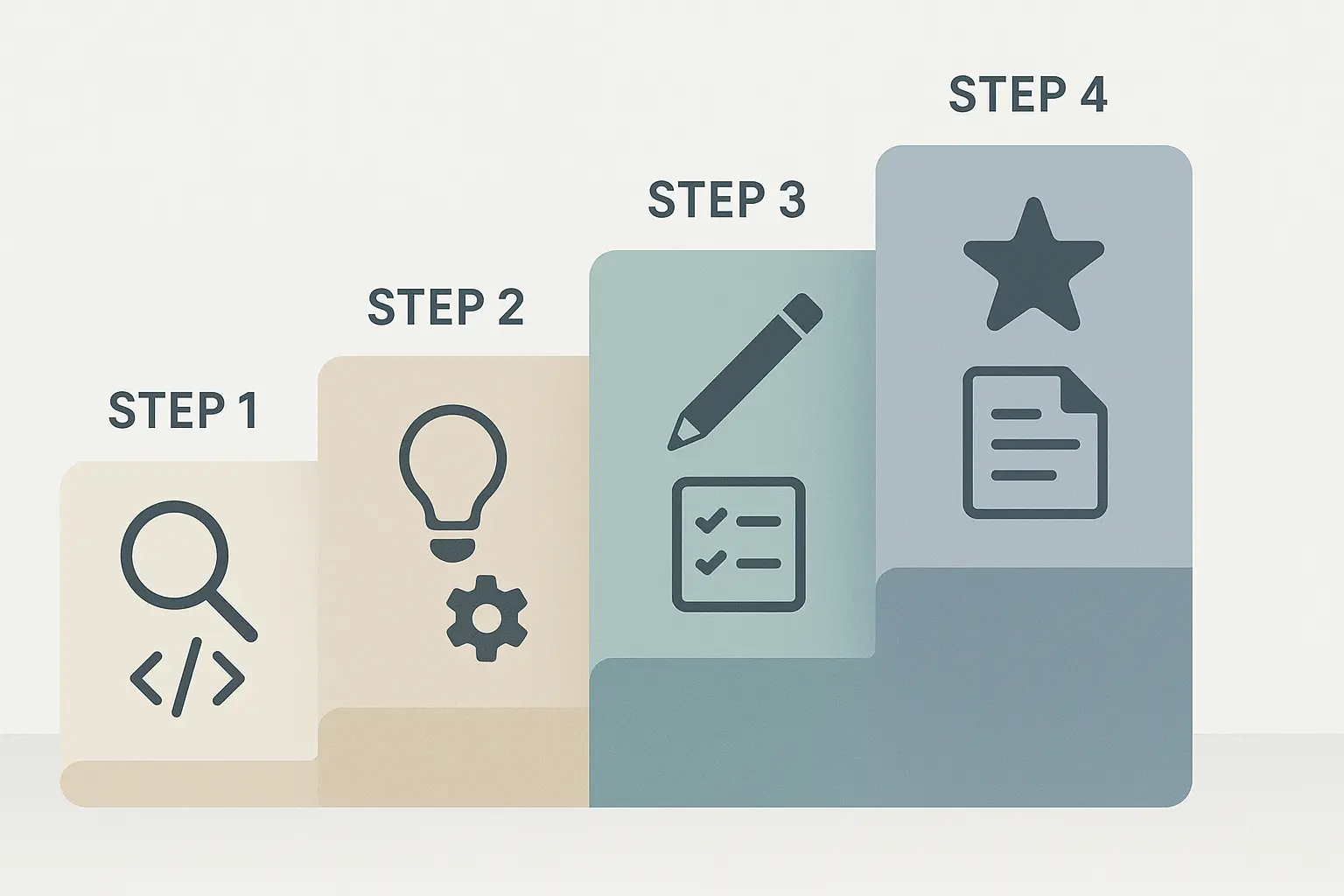Your best writer just delivered a masterpiece. It’s insightful, beautifully written, and perfectly captures your brand voice. You publish it with high hopes.
Three months later, it’s buried on page nine of Google. What went wrong?
The hard truth is that great writing alone doesn’t guarantee visibility. Search engines aren’t literary critics; they’re complex algorithms that reward content for solving specific problems in a structured, comprehensive way. This is where the disconnect happens: a brilliant writer creates for a human but forgets that the first reader is a machine.
The solution isn’t to write for machines. It’s to give human writers a data-driven blueprint that satisfies both the algorithm and the end user. This is the magic of a modern, AI-generated content brief. It transforms the guesswork of SEO into a science, creating a framework for content that’s built to rank from the ground up.
What Was Wrong with the Old Way?
For years, a “content brief” might have been a simple document with a target keyword, a title, and a few bullet points jotted down by a marketer. It was based more on intuition than on information.
This manual approach has three critical flaws in today’s competitive landscape:
-
It’s Subjective: The brief reflects one person’s opinion of what should rank, not what the data shows is ranking.
-
It’s Inefficient: Manually analyzing the top 10 search results for every keyword—including their structure, key topics, and user intent—can take hours. Scaling this across dozens of clients is nearly impossible.
-
It’s Incomplete: A manual review often misses subtle but crucial ranking factors, like semantic entities, user sentiment, and internal linking opportunities that algorithms easily spot.
An AI-powered brief doesn’t replace strategy; it supercharges it with data at a scale humans can’t match. It’s the difference between giving a chef a detailed recipe and just telling them to “make something with chicken.”
Anatomy of a Winning AI-Generated Brief
Think of an AI-generated brief not as a set of rigid instructions but as a detailed map of the search landscape. It shows your writer the exact terrain they need to cover to win. Here’s what’s inside.
1. Competitive SERP Analysis
Before you can outrank your competitors, you need to understand precisely why they are ranking. AI systems analyze the top 10-20 search results for your target query, distilling a massive amount of data into actionable insights.
This isn’t just about word count. The analysis breaks down:
Content Structure: Which H2s and H3s are common? Are competitors using lists, tables, or FAQs? The answers reveal the format users expect.
Average Metrics: The brief calculates the average word count, readability score (e.g., Flesch-Kincaid), and image count of top-ranking pages. A recent SEMrush study identified on-page factors like these as foundational for performance.
Top Competitors: It identifies the exact URLs you’re up against and deconstructs their approach, giving you a clear benchmark.
This analysis forms the foundation of the entire brief. With powerful AI-powered SEO automation, this process goes from a half-day research project to a five-minute task.

2. User Intent Modeling
Why is the user searching for this query? Are they looking for a definition (Informational), a list of options (Commercial Investigation), a place to buy (Transactional), or a specific website (Navigational)?
AI excels at decoding intent by analyzing the language and types of content that are already ranking.
If the top results are “how-to” guides, the intent is informational.
If they are product comparison pages, the intent is commercial.
If they are eCommerce category pages, the intent is transactional.
The brief defines the primary and secondary user intents, ensuring the writer creates content that answers the user’s underlying question. Misaligning with user intent is one of the fastest ways to get ignored by Google.

3. Keyword and Topic Clustering
Gone are the days of keyword stuffing. Modern SEO is about topical authority. Search engines want to see that you’ve covered a subject comprehensively.
An AI brief moves beyond a single primary keyword. It uses Natural Language Processing (NLP) to analyze top results and identify clusters of related topics and LSI (Latent Semantic Indexing) keywords. HubSpot’s research has shown that organizing content into “topic clusters”—a core pillar page with related sub-topic pages—dramatically improves search visibility.
The brief will provide:
Primary Keyword: The main target.
Secondary Keywords: Important variations and long-tail queries.
Topical Clusters: A list of related sub-topics that should be included to demonstrate expertise and build a comprehensive resource.
This ensures the writer covers the topic from all angles, satisfying both curious readers and Google’s E-E-A-T (Experience, Expertise, Authoritativeness, and Trustworthiness) guidelines.
4. Entity Inclusion for Semantic SEO
Here’s where AI truly leaves manual analysis behind. An “entity” is a specific, well-defined thing or concept—a person, place, organization, or idea. Google’s algorithm now functions more like an entity graph, connecting concepts rather than just matching keywords.
For example, for the topic “best camera for travel,” related entities might include:
Brands: Sony, Canon, Fujifilm
Camera Types: Mirrorless, DSLR, Point-and-shoot
Concepts: Image stabilization, Aperture, Megapixels, Battery life
An AI-powered brief scrapes the top-ranking articles and identifies the most frequently mentioned entities. Including these in your content helps Google understand its context and relevance with greater accuracy. It’s like speaking the search engine’s native language.
5. Data-Driven Structure and Outline
Instead of guessing at a good outline, the brief provides a recommended structure based on what’s already winning. It suggests H2 and H3 headings based on the most common questions and topics found in the top results.
This doesn’t mean you have to copy your competitors. It means you have a proven framework to build upon and improve. The AI might identify a question that competitors mention but don’t answer well, creating a “content gap” opportunity for you to fill. This is a core part of effective white label SEO execution—finding and filling these gaps at scale.
6. Internal and External Linking Opportunities
Links are the currency of the web. A well-structured brief uses automation to provide high-value linking suggestions.
Internal Links: The brief identifies other relevant pages on your own website to link to. This helps distribute link equity (or “PageRank”) and guides users and search crawlers through your site.
External Links: It suggests authoritative, non-competing external sites to link out to. Linking to credible sources is a trust signal that shows your content is well-researched. Research by Backlinko consistently shows a correlation between the number of referring domains and higher rankings, highlighting the importance of this authority-building strategy.

The Result: Empowering Creativity, Not Replacing It
An AI-generated brief doesn’t turn writers into robots. It does the opposite.
By handling the heavy lifting of data analysis, it frees the writer to do what they do best: tell a compelling story, add unique insights, and create a fantastic reader experience. The brief provides the “what” and the “why,” so the writer can focus on the “how.”
The result is content that is both creatively excellent and technically optimized to perform—a piece that satisfies the human reader and the algorithmic gatekeeper.
Frequently Asked Questions (FAQ)
Q1: Does using an AI content brief mean AI is writing the content?
Not at all. The brief is the blueprint, not the final product. It provides the data-driven outline and key elements for a human writer to use. The writer still crafts the narrative, infuses the brand voice, and adds their unique expertise. Think of it as giving a GPS to a talented driver—it guides them, but they’re still the one in control.
Q2: What is an “entity” in SEO, really?
An entity is any distinct and identifiable thing or concept. For Google, “Apple” can be a fruit or a technology company. By including other related entities in your content (like “iPhone,” “Tim Cook,” or “Cupertino”), you give Google the context it needs to understand that you’re talking about the company. AI briefs help you identify all the relevant entities you should mention.
Q3: Can’t I just use a keyword research tool for this?
Keyword tools are great for finding target queries, but that’s only the first step. They tell you what people are searching for, but they don’t tell you why the current top pages are ranking. An AI-generated brief deconstructs those winning pages to give you a complete competitive analysis—from content structure and user intent to semantic topics and internal linking—that a simple keyword list lacks.
Q4: How long does it take to create an AI-powered brief?
While a thorough manual brief could take several hours, an automated system can analyze the SERPs and generate a comprehensive brief in minutes. This is a game-changer for agencies and content teams needing to produce optimized content efficiently and at scale.
The Future is a Collaboration
The debate over “human vs. AI” in content is missing the point. The future belongs to those who master “human + AI.” By leveraging automation to handle complex data analysis, you empower your creative team to produce their best work—work that not only resonates with readers but also earns the visibility it deserves.
Ready to see how data can transform your content strategy? Explore our resources on building a modern, omnichannel growth SEO plan that connects content directly to business results.

